45 facts about SeaBus at its 45th anniversary
45 facts about SeaBus at its 45th anniversary
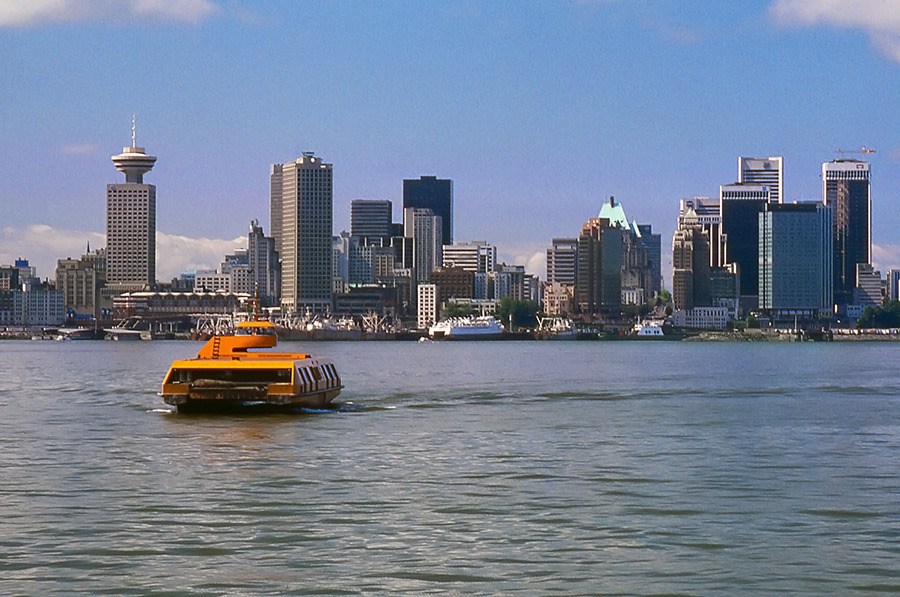
On June 17, 1977, the SeaBus sailed its maiden voyage across the Burrard Inlet, becoming the Metro Vancouver transit system’s first passenger ferry service.
That means it’s celebrating its 45th anniversary!
The SeaBus has provided millions of trips for more than 45 years, serving as a vital connection between Vancouver and the North Shore. But like the SkyTrain, it is an icon that is uniquely Metro Vancouver — there is only one SeaBus in the world. It is also a popular tourist attraction that provides unrivaled views of both the Vancouver skyline and North Shore mountains and everything in between – including the occasional orca whale!
Here are 45 facts about SeaBus at its 45th anniversary:
1 | The SeaBus is a passenger ferry that carries people from Waterfront Station in downtown Vancouver to Lonsdale Quay in North Vancouver.
2 | It takes approximately 12 minutes per sailing and just three minutes to load/unload passengers, making the entire crossing 15 minutes in length.
3 | Each of our SeaBus vessels is operated with a crew of four: the master, one mate and two attendants.
4 | Each SeaBus can transport about 385 people at a time.
5 | SeaBus cruises at a speed of 11.5 knots or 21.3 kilometres per hour.
6 | The crossing is 1.75 nautical mile or 3.24 kilometres.
7 | A SeaBus trip is a two-zone fare.
8 | The SeaBus started operating with two vessels on June 17, 1977: the Burrard Otter and Burrard Beaver.
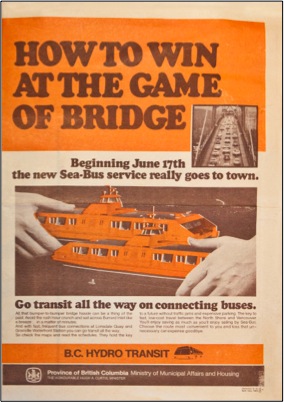
9 | The Burrard Beaver is still in service today as a spare vessel.
10 | The SeaBus was orange and operated by BC Hydro Transit at launch.
11 | The SeaBus is currently operated by Coast Mountain Bus Company, which took to the helm in 1999 after TransLink’s establishment.
12 | SeaBus was operated by BC Hydro’s transit division between 1977 and 1979, then Urban Transit Authority between 1979 and 1982, and BC Transit between 1982 and 1999.
13 | The SeaBus name was written as “Sea-Bus” at launch.
14 | The original SeaBus ticket machines were the first ticket machines ever used on our transit system.
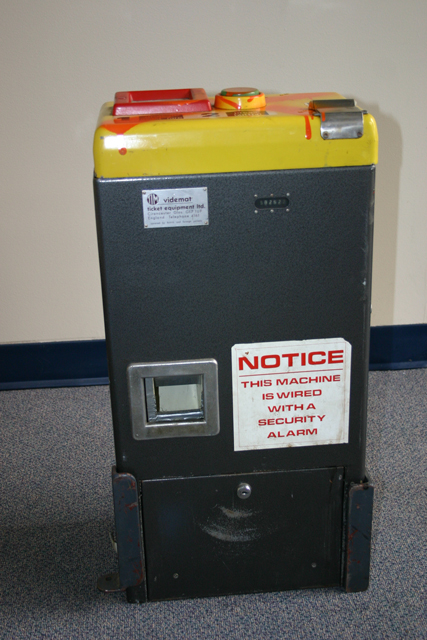
15 | The machines were essentially a photocopier: the printed ticket was a cash register-sized length of paper with an image of all the coins that you had deposited.
Special thanks to Derek Cheung for sharing this fun fact!
16 | Eventually, fares were paid using a token that featured the province’s coat of arms on one side and the SeaBus on the other.

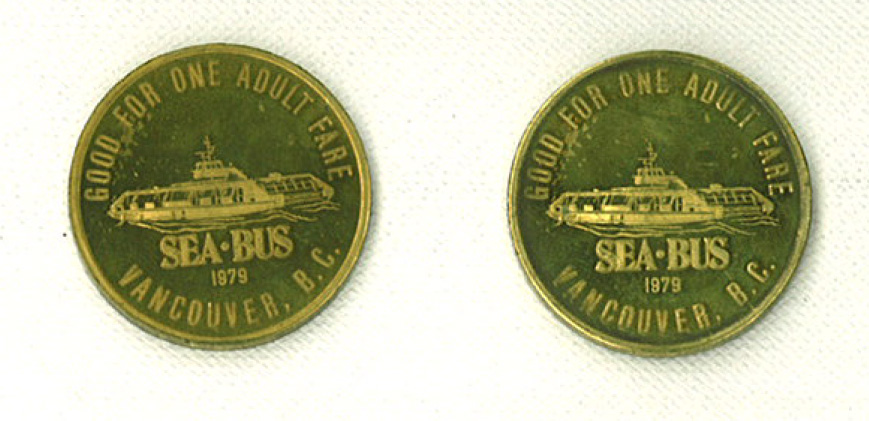
17 | There are four vessels currently in service: Burrard Beaver, Burrard Pacific Breeze, Burrard Otter II, and the Burrard Chinook.
18 | The SeaBus vessels are double ended, which means there’s no need to turn around when leaving the dock. The captain just switches stations and off they go.
19 | The SeaBus vessel has four propellers, each operated by its own engine. This offers 360-degree operation for high maneuverability.
20 | The SeaBus can operate using only three of the four engines, if necessary.
21 | The vessels utilize a catamaran hull design, which ensures stability with shifting weight as passengers disembark on one side, then board on the other.
22 | The vessels are made from aluminum.
23 | The newest SeaBus vessel in our fleet is the Burrard Chinook.
It is named as a tribute to the largest and most iconic of the Pacific salmon species. The “Chinook” name is translated into hən̓q̓əmin̓əm̓, the traditional language of the Musqueam Indian Band and the Tsleil-Waututh Nation, and the traditional language of the Squamish Nation, and displayed on the vessel.
24 | Artists Kelly Cannell, Siobhan Joseph, and Angela George designed the art wrap surrounding the exterior of the Burrard Chinook vessel.
The art illustrates the lifecycle of the Chinook salmon, as well as the historical importance of the Chinook salmon to its ecosystem.
25 | The Burrard Chinook name was chosen to meet Transport Canada’s regulations for marine vessels and be consistent with the marine life theme.
It also has to be easy to say and understand over the radio transmission and be an appropriate length for displaying on the SeaBus and emergency equipment like lifejackets.
26 | The SeaBus sails on the shared unceded territories of xʷməθkʷəyə̓m (the Musqueam Indian Band), Sḵwxw̱ ú7mesh Úxwumixw (the Squamish Nation), and səlilwətaɬ, (the Tsleil-Waututh Nation.
27 | The SeaBus joined the Frequent Transit Network on May 19, 2017.
This meant earlier 15-minute sailings on weekends and until 9 p.m. every day. The Frequent Transit Network (FTN) is a network of corridors where transit service runs at least every 15 minutes in both directions throughout the day and into the evening, every day of the week.
28 | The SeaBus started operating 10-minute rush hour service on September 3, 2019.
The onset COVID-19 pandemic saw adjustments to transit service across the network. Ten-minute service returned on September 6, 2021.
29 | SeaBus fleet and infrastructure projects are underway to improve the quality of our service.
As part of TransLink’s Maintenance and Upgrade Program, we recently completed seismic and accessibility upgrades at Waterfront Station’s SeaBus terminal. Currently, we’re replacing aging operational equipment at both SeaBus terminals to ensure their continued safety and reliability for years to come.
30 | The Burrard Otter II and Burrard Chinook both arrived aboard a heavylift carrier ship and took about four hours to unload.
31 | When the Burrard Chinook traveled from the Netherlands to Vancouver, it took five weeks and included a trip through the Panama Canal.
32 | In a typical year, the SeaBus makes more than 49,000 trips across the Burrard Inlet.
33 | We are undertaking a SeaBus propulsion feasibility study to look at how an electric SeaBus could reduce GHG emissions by more than 85 per cent compared to a diesel SeaBus.
This is part of our Climate Action Strategy and commitment to net-zero greenhouse emissions by 2050. An electric SeaBus could save over 500,000 litres of diesel fuel annually.
34 | In fall 2021, the SeaBus averaged 9,000 daily boardings from Monday through Saturday, and 6,000 boardings on Sundays and holidays.
35 | The SeaBus terminals are the only place in the transit network that uses the Spanish Solution, where passengers disembark on one side and passengers board on another.
36 | SeaBus boasts a high on-time performance of 99.9 per cent.
37 | The SeaBus terminals and vessels were among the first places to receive Wi-Fi as part of a partnership with Shaw.
Shaw Go Wi-Fi went live at the Waterfront Station and Lonsdale Quay SeaBus terminals in late 2015 and in mid-2016, Wi-Fi also became available onboard SeaBus vessels. We are currently in the midst of a network-wide roll out of Shaw Go Wi-Fi.
38 | The Burrard Chinook was built in the Netherlands, the Burrard Otter II was built in Singapore, the Burrard Pacific Breeze was built in Victoria/Vancouver, and the Burrard Beaver was built in Victoria.
39 | For Expo 86, BC Transit changed the SeaBus livery to white with one red and one blue stripe as well as a BC flag label, matching the SeaBus with the newly built SkyTrain and new orders of buses.
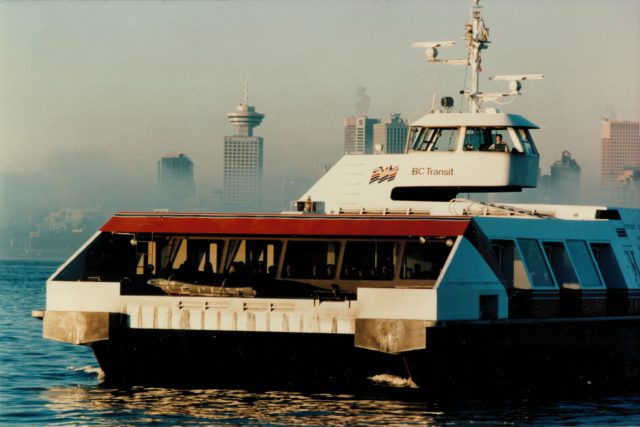
40 | When the SeaBus travels with a full load of 385 passengers, the crew refers to it as a “lock out.”
41 | The SeaBus must follow Transport Canada regulations.
42 | Captain Joe Lutz is the only original member of the SeaBus crew still working for Coast Mountain Bus Company. Naturally, he will celebrate his 45th anniversary with the company when SeaBus turns 45!
43 | The first known passenger crossing across the Burrard Inlet was in the mid-1860s.
It was delivered on a private rowboat.
44 | Before the SeaBus, the North Vancouver Ferry and Power Company operated ferry service across the Burrard Inlet for 50 years between 1908 and 1958.
45 | Burrard Chinook was the first SeaBus vessel to make a journey back and forth to Victoria harbour under its own power.
![]()
Do you have any SeaBus fun facts? Share them with everyone by leaving it in the comments below.






I believe SeaBus was operated by BC Hydro Transit until April 1,1980, when the Metro Transit Operating Company took over until 1985 when it was merged with BC Transit.
Point 45: “back and forth to Victoria Harbour” – does that mean Chinook made a round trip from Waterfront Station all the way to downtown Victoria under its own power during a test run? (~ 70 nautical miles each way)
Number 46, the new SeaBuses were designed by Vancouver-based naval architecture firm Robert Allan Ltd.!
Orange seabus! That’s pretty cool. Imagine the skytrain being all orange. That would be interesting too. I think there was a relatively brief period when buses were orange. There was a transit system after BC Hydro but before BC Transit. Urban Transit Authority or something. I’m not sure if that eventually became BC Transit. Anyway, interesting just how different vehicles can look when they have a totally different paint job.